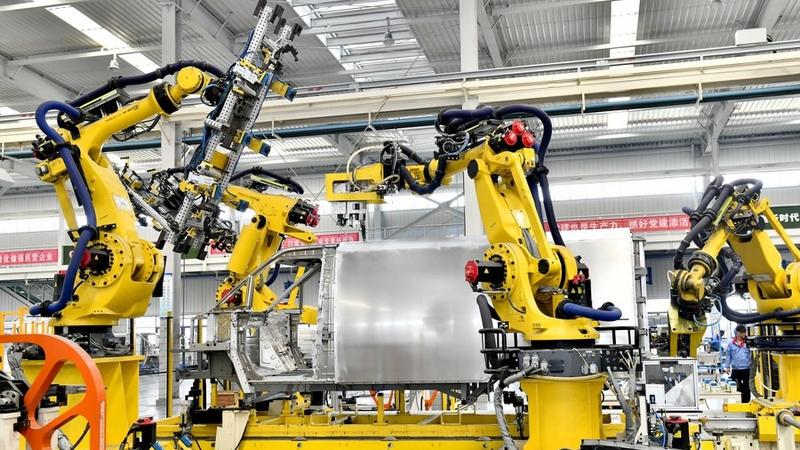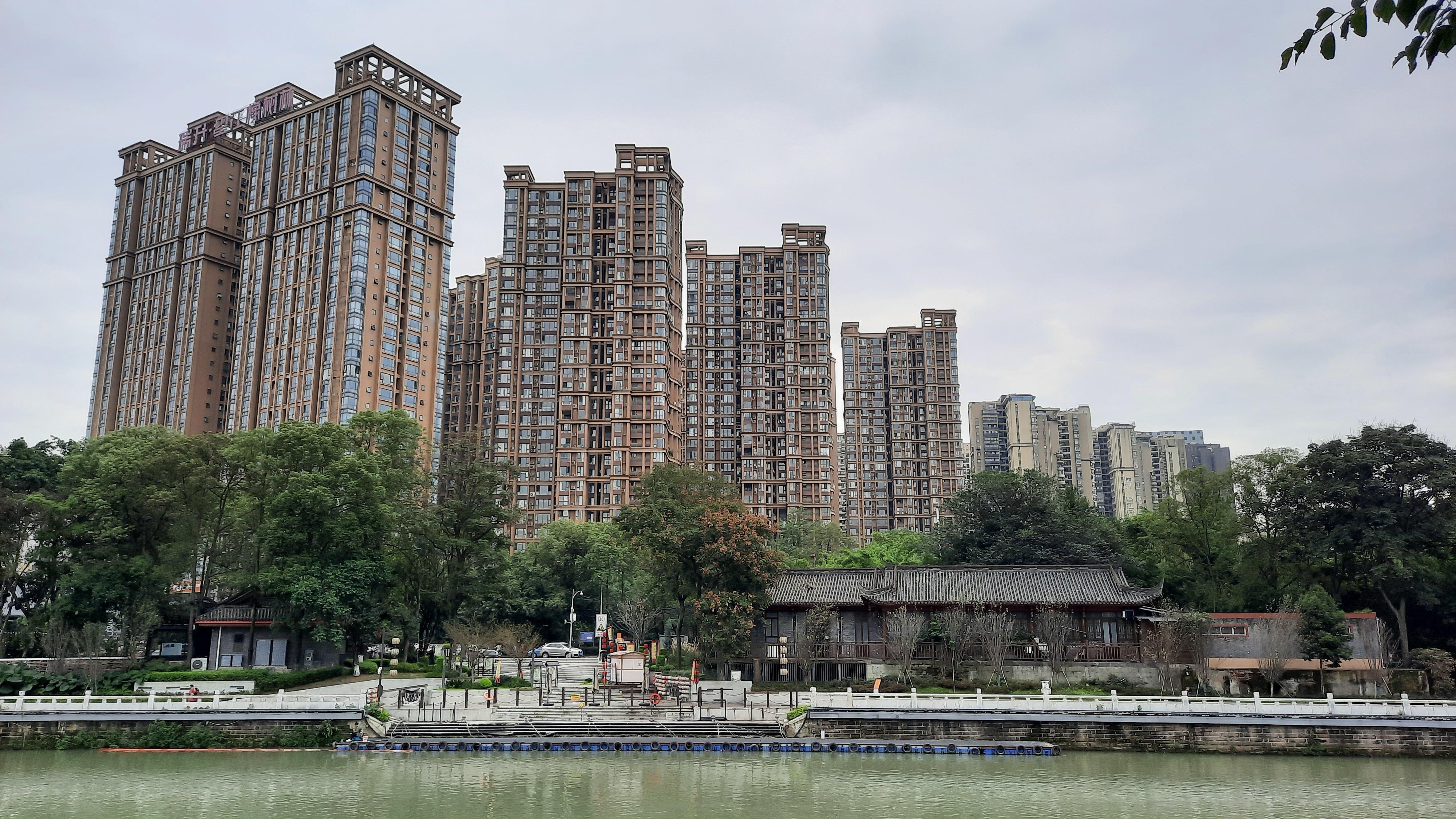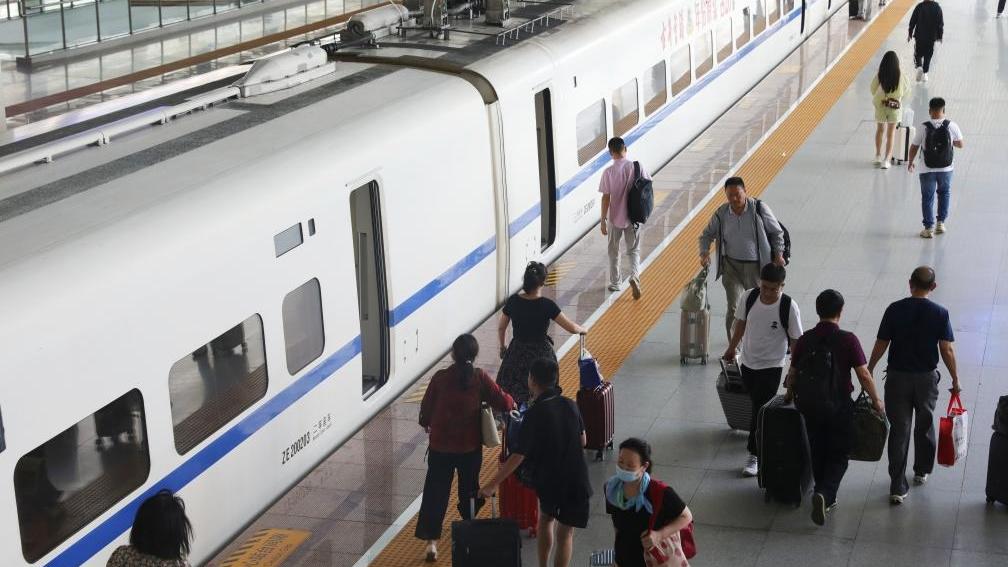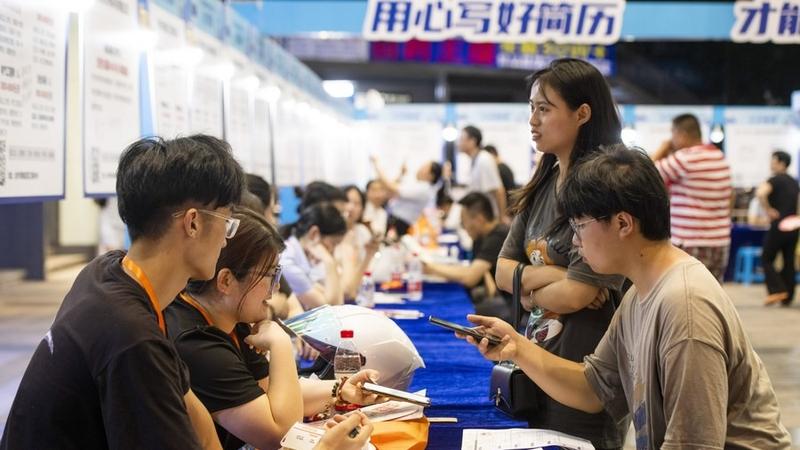 Robots work on an assembly line of a factory of a private enterprise in Zouping City, east China's Shandong province, Sept 13, 2023. (PHOTO / XINHUA)
Robots work on an assembly line of a factory of a private enterprise in Zouping City, east China's Shandong province, Sept 13, 2023. (PHOTO / XINHUA)
BEIJING- China's value-added industrial output, an important economic indicator, went up 6.6 percent year-on-year in November, data from the National Bureau of Statistics showed Friday.
The growth accelerated from the 4.6-percent rise registered in October, according to the NBS.
On a monthly basis, industrial output edged up 0.87 percent in November.
High-tech manufacturing registered a 6.2-percent increase in industrial output in November, up 4.4 percentage points from October, official data revealed
Most sectors logged faster industrial output growth rates in November compared with a month earlier. The output of equipment manufacturing expanded 9.8 percent year on year last month, up 3.6 percentage points from that in October and driving up the overall industrial output by more than 1 percentage point.
High-tech manufacturing registered a 6.2-percent increase in industrial output in November, up 4.4 percentage points from October, the data revealed.
ALSO READ: Japanese, ROK firms bullish on China's high-tech development
High-tech products such as solar cells, service robots, and integrated circuits continued their stellar performance in November, with their output rising 44.5 percent, 33.3 percent, and 27.9 percent, respectively.
In the first 11 months, China's industrial output grew 4.3 percent from the same period a year earlier, up 0.2 percentage points from the Jan-Oct growth, the NBS said.
The industrial output is used to measure the activity of enterprises each with an annual main business turnover of at least 20 million yuan ($2.8 million).
 Workers are busy packing products before this year's Singles Day shopping spree at an e-commerce seller's warehouse in Huaian, Jiangsu province, on Nov 1, 2023. (ZHANG ZHAOJIU / FOR CHINA DAILY)
Workers are busy packing products before this year's Singles Day shopping spree at an e-commerce seller's warehouse in Huaian, Jiangsu province, on Nov 1, 2023. (ZHANG ZHAOJIU / FOR CHINA DAILY)
Rise in retail sales
On China's consumption strength, the retail sales of consumer goods climbed 10.1 percent year-on-year in November, according to the official data.
The growth pace accelerated from a rise of 7.6 percent registered in October, said the NBS.
Total retail sales of consumer goods topped 42.79 trillion yuan in the January-November period, up 7.2 percent from one year earlier, according to the NBS
Since the beginning of the year, the economic performance has continued to pick up, and the demand for goods and services has continued to recover, NBS spokesperson Liu Aihua told a press conference.
Retail sales in the country's urban regions rose 10 percent year-on-year last month, while that in rural areas expanded 10.4 percent.
Total retail sales of consumer goods topped 42.79 trillion yuan in the January-November period, up 7.2 percent from one year earlier, according to the NBS.
Online retail sales jumped 11 percent year-on-year to 13.96 trillion yuan in the first 11 months. In particular, online retail sales of physical goods rose 8.3 percent year-on-year to 11.77 trillion yuan, accounting for 27.5 percent of the total retail sales of consumer goods.
ALSO READ: China's economic recovery set to gain further momentum
On expanding domestic demand, efforts should be made to stimulate consumption with potentials and expand productive investment to create a virtuous cycle of mutual promotion between consumption and investment, according to the annual Central Economic Work Conference held from Monday to Tuesday.
With the effective implementation of policies to boost domestic demand, China's consumption will see further expansion, Liu said.
 This photo taken from the Wangjiang Pavilion Park shows residential buildings near the Jin River in Chengdu, capital of Sichuan province, China, on Oct 20, 2023. (GARY CHIU / CHINA DAILY)
This photo taken from the Wangjiang Pavilion Park shows residential buildings near the Jin River in Chengdu, capital of Sichuan province, China, on Oct 20, 2023. (GARY CHIU / CHINA DAILY)
Drop in home prices
Friday's data also indicated that major Chinese cities reported falling home prices in November.
In the four first-tier cities, namely Beijing, Shanghai, Guangzhou and Shenzhen, prices of new homes edged down 0.3 percent last month, while that of resold homes dropped 1.4 percent
The bureau said that 70 large and medium-sized cities saw month-on-month declines in both new and second-hand home prices.
In the four first-tier cities, namely Beijing, Shanghai, Guangzhou and Shenzhen, prices of new homes edged down 0.3 percent last month, while that of resold homes dropped 1.4 percent.
Home prices in 31 second-tier cities and 35 third-tier cities in general also went down in November from a month earlier.
ALSO READ: China's industrial output up 4.6% in October
On a year-on-year basis, home prices witnessed mixed performances in Chinese cities.
For new homes, first-tier and second-tier cities saw marginal price increases but smaller cities reported drops. For resold homes, there were declines across the board.
NBS spokesperson Liu said some indicators have shown signs of improvement in the market due to modified policies in the property sector.
In the first 11 months, China's investment in property development dropped 9.4 percent year-on-year, while commercial housing sales shrank 8 percent in terms of floor area and dropped 5.2 percent in terms of value, official data showed.
These figures demonstrate that China's property sector remains in the process of adjustment, which is conducive to the stable and healthy development of the market in the long run, Liu noted.
She said the country will make active but prudent efforts to defuse risks facing the property sector and work for further improvement of the market.
 Passengers get on and off a train at Xuzhou East Railway Station in Xuzhou, east China's Jiangsu province, Aug 1, 2023. (PHOTO / XINHUA)
Passengers get on and off a train at Xuzhou East Railway Station in Xuzhou, east China's Jiangsu province, Aug 1, 2023. (PHOTO / XINHUA)
Service production up
Meanwhile, the NBS said the country's service production index went up 9.3 percent year-on-year in November.
The growth rate was 1.6 percentage points faster than the October level, it added.
In the January-November period, investment in infrastructure construction and the manufacturing sector expanded 5.8 percent and 6.3 percent, respectively, compared with a year earlier, while property development investment dropped 9.4 percent
Sub-reading for the hospitality industry surged by 30.6 percent year-on-year. The sub-index tracking the performance of transportation, warehousing and postal services climbed 15.1 percent, while that for information transmission, software and IT services expanded 13.3 percent, according to the bureau.
The growth paces of the aforementioned industries logged month-on-month increases in November, the NBS said
In the first 11 months, the service production index increased by 8 percent year-on-year, 0.1 percentage points faster than that registered in the January-October period.
ALSO READ: Services data show signs of recovery
The combined revenues of major service enterprises rose 7.7 percent year-on-year in the January-October period, up from an increase of 7.1 percent in the first nine months.
In November, indexes measuring business activities in water transportation and in monetary and financial services stayed above 55 percent.
Commenting on Friday's data, NBS spokesperson Liu said China's service sector saw "comparatively fast growth" last month, with contact-based services continuing to recover.
Rise in fixed-asset investment
The official data also revealed that China's fixed-asset investment increased by 2.9 percent year-on-year to around 46.08 trillion yuan in the first 11 months of 2023.
This growth rate was the same as that of the first 10 months of this year, according to the National Bureau of Statistics.
In the January-November period, investment in infrastructure construction and the manufacturing sector expanded 5.8 percent and 6.3 percent, respectively, compared with a year earlier.
ALSO READ: Boosting consumption high on China's 2024 agenda
Overall private investment edged down 0.5 percent from a year earlier, but when excluding the property sector, it witnessed a robust increase of 9.1 percent.
Investment in high-tech industries climbed 10.5 percent year-on-year. Capital invested in the manufacturing of aerospace equipment and medical devices jumped 16.2 percent and 14.8 percent, respectively, while that allocated to professional sci-tech services and services for commercialization of scientific and technological achievements surged 34.4 percent and 33.6 percent, respectively.
Fixed-asset investment grew 0.26 percent in November 2023 compared with the previous month, according to the bureau .
Property development investment cools
On property development, the NBS data showed that China's investment cooled in the first 11 months of 2023, down 9.4 percent year-on-year.
Investment in residential buildings amounted to 7.89 trillion yuan, down 9 percent year-on-year, NBS data showed.
Commercial housing sales shrank 8 percent year-on-year in terms of floor area to 1.01 billion square meters.
In terms of value, commercial housing sales dropped 5.2 percent year-on-year to 10.53 trillion yuan.
"These figures indicate that China's property sector is still in the process of adjustment," the bureau's spokesperson Liu said.
READ MORE: China to introduce more policies to restore, spur consumption
But the property market has recently shown some marginal improvement as the country's economy continued to recover and supportive measures took effect, Liu said.
The just-concluded Central Economic Work Conference has called for efforts to defuse risks in the property sector, equally meet the reasonable financing needs of real estate enterprises of different ownerships and promote stable and healthy development of the property sector.
With the implementation of relevant policies, the real estate market is expected to further improve, said the spokesperson.
The property development climate index, compiled by the NBS, came in at 93.42 points in November.
 Job seekers inquire about job opportunities at a job fair for college graduates in Jinhua City, east China's Zhejiang province, July 21, 2023. (PHOTO / XINHUA)
Job seekers inquire about job opportunities at a job fair for college graduates in Jinhua City, east China's Zhejiang province, July 21, 2023. (PHOTO / XINHUA)
Improvement in employment
On China's job markets, the employment situation has registered stable performance while consistently seeing improvement, Liu said
The country's surveyed urban unemployment rate stayed at 5 percent in November for a third month, the spokesperson said.
From January to November, the average surveyed urban unemployment rate came in at 5.2 percent, 0.4 percentage points lower than that of the same period of last year, according to Liu.
Favorable conditions conducive to maintaining employment stability continue to accumulate despite structural contradictions in the employment market, according to Liu.
In the next stage, Liu underlined the importance of strengthening vocational training, optimizing recruitment services, and taking steps to ensure the stable employment of key groups.
Regarding the youth unemployment rate, Liu added that China is working on perfecting the calculation method of the data, and will give relevant updates upon the completion of the work.


